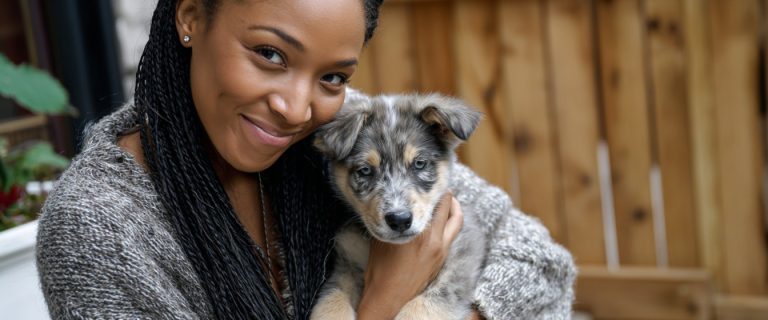Are you worried about how to introduce a visiting dog to your dog?
If your relatives are coming over for the holidays or you’re dog sitting, you might be anxious about how the pups will get along.
Fortunately, we’re here to help you with 7 superb tips on introducing dogs smoothly.
Check them out!
7 Practical Tips on How to Introduce Dog to Visiting Dog

You never know when your relatives will drop by for a visit and bring their dog around or when your friends will ask you to board their pets for a night or two.
Moreover, introducing your dog to a visiting dog is an excellent way to judge how your dog would accept a new puppy.
It will also show you if you can manage two dogs and are ready for a second dog.
That’s why knowing how to introduce your dog to a visiting dog might come in handy.
After all, you don’t want to make a mistake and start on the wrong foot.
Dogs should have positive experiences with one another if you ever hope for them to be friends. Let’s see how it’s done.
#1 Consider The Dogs’ Personality

Before you agree to accept a relative’s dog in your house or dog sitting for a friend, you should consider the dogs’ personality.
Think about how your pet reacts to the presence of other dogs. Is the dog pushy, timid, or aggressive?
Dominant dogs might do better with puppies or submissive dogs since they pose less of a threat.
Shy or timid animals, on the other hand, will get along better with mellow dogs who won’t push them around.
Talk to the other dog’s owner about their pet’s personality to judge if meeting the two pets is a good idea.
Some dogs just don’t play well with others, and there’s little you can do about it without extensive socialization.
Unfortunately, you might not have much choice if your relatives bring their pet over for the holidays. In such cases, keeping the dogs separated might be the best course of action.
#2 Choose a Neutral Ground

As with people, first impressions are important when two dogs meet for the first time.
It’s vital that the meeting goes smoothly so that both dogs have a positive experience with each other’s presence.
That’s why it’s better to introduce the dogs in a neutral place to avoid triggering the dogs’ territorial and protective instinct.
For example, you can go to the dog park, a nearby field, or a parking lot.
Never allow friends/family to leave their visiting dogs inside the house without proper introductions.
Both dogs will be too stressed for the introduction to go smoothly and might react defensively.
If you’re thinking about adopting a puppy, it’s even more important to introduce the dog on neutral ground to avoid conflicts.
#3 Have the Dogs Leashed
When you’re introducing your dog to a visiting dog, you should have them both on a leash.
You never know how your dog will react to a visiting dog or how the other dog will behave.
Don’t make assumptions, because dogs can be unpredictable when stressed.
The leash is also for your peace of mind. You’ll be able to separate the two dogs immediately and do damage control.
Some dogs are reactive towards animals when leashed.
In other words, they bark excessively and struggle on the leash, but are calm when off the leash.
If that’s the case with your pooch, you should have the meeting in a safe, enclosed area.
#4 Introduce From A Distance
One way to introduce your dog to a visiting dog is “parallel walks.” Here’s how it works:
- In the neutral location you’ve chosen, walk your dog 30-50 feet away from the visiting dog and their owner.
- In this way, the dogs see each other, but they can’t interact or touch, so they’ve got time to get used to each other’s presence.
- Slowly narrow the distance and praise with high-value treats as long as your dog doesn’t show signs of aggression or excitement.
- Let the dogs sniff each other when they’re close enough as long as they are relaxed.
- Praise your dogs for appropriate behavior and call them apart after a few seconds.
- Repeat.
Another way to introduce dogs on a walk is to walk them towards each other.
Be careful not to hold the leash too tightly, or you’ll send the wrong message to the other dog:
- You and the other owner are at opposite ends and start walking the dogs towards each other.
- Praise and reward your dog if they stay calm while the other dog is approaching.
- Move slowly and stop if your dog shows any signs of being uncomfortable. Talk soothingly and continue if the dog is relaxed.
- When the dogs are calm, let them sniff each other and break them apart after a couple of seconds.
- Repeat the exercise. You want to build a positive connection before you take the dogs back home.
Here’s a visual guide on how to do it:
#5 Observe the Body Language
When you’re introducing visiting dogs or introducing dogs when dog sitting, the most important thing is to observe the body language.
You should know if the introduction is going well, or you have to take a step back and reevaluate.
If you reach the point when the dogs are fighting/biting, it would be hard to fix that first impression, and the dogs will remain wary.
So, watch out for signs of aggression, such as:
- Raised hackles
- Rigid or tense body
- Snarling
- Pulled-back lips and showing teeth
- Lunging
- Licking lips and yawning
Separate the dogs immediately and don’t wait for the situation to escalate.
Try again when both dogs are relaxed and calm.
If you get the same result, you probably won’t be able to dog sit the two dogs together or welcome visiting dogs.
If the introductory walk goes to plan and the dogs don’t mind each other’s presence, you can bring them home.
Walk the dogs side-by-side to build on the connection you’ve already established.
Take a look at these top ten signs of aggression you should never ignore:
#6 Supervise
No matter if you’re dog sitting, boarding a friend’s dog, or living with a relative’s dog for the holidays, you have to supervise your pets.
Even if the dogs were on their best behavior outside, you never know how your dog would react when another “invades” their territory.
The dog might become defensive, protective, or possessive, and you should be there to deescalate the situation.
You can keep the dogs in separate rooms or use baby gates to keep them away from each other when no one is around.
A barrier also works if the dogs don’t get along but have to stay in one house.
#7 Take Preventive Measures
When you’ve got a visiting dog, there might be “aggression” over resources, such as food, attention, and toys.
To avoid conflicts and problems:
- Don’t allow the visiting dog to use your pet’s toys and bed. Ask your friend/relative to bring the visiting dog’s belongings.
- Feed the dogs in separate rooms and move your dog’s bowl where the visiting dog won’t reach it.
- Pay an equal amount of attention to both dogs. You don’t want your pet to feel that you’re neglecting them in favor of the visiting dog.
- If you’re dog sitting, ask the owner for instructions and their vet’s number.
- Make sure that both dogs are up-to-date with their shots and are healthy.
If you have to separate fighting dogs, make loud noises, throw a blanket on them, or hose the dogs down.
Never grab the dog’s face or collar since you can get bitten.
Specialists also recommend “the wheelbarrow method” where you grab your dog’s hind legs and wheel them away from the other pet.
However, that’s still risky and requires another person to deal with the second dog.
I recommend checking out these tips from Zak George for more ways to avoid problems with two dogs meeting for the first time!
Introducing your dog to a visiting dog isn’t rocket science, but it takes time and requires good management abilities and steel nerves.
Dogs sense anxiety and uncertainty, and if you’re afraid or anxious, they will know it and react defensively.
If you’re not confident that your dog will get along with others, you should say so when relatives and friends ask to bring their pet along.
Don’t put your dog in an uncomfortable situation because you’ll lose your pet’s trust.
What do you think about these 7 simple tips on how to introduce a visiting dog to your dog ? Have you ever had to dog sit for a friend or temporarily live with a second dog? Share below!
Author
-

I’ve grown up surrounded by animals – dogs, cats, cows, goats, sheep, and horses and that has shaped me into what I am today – a crazy cat lady who always has a place for one more cat (or a dog). I’ve got two female cats – Kitty and Roni, and two tomcats – Blacky and Shaggy, but I also feed my neighbors’ cats when they come for a visit. I just can’t say no to them.
View all posts



